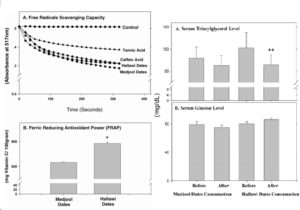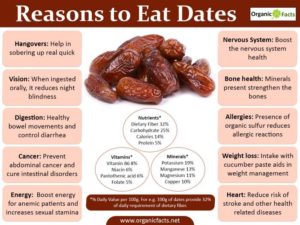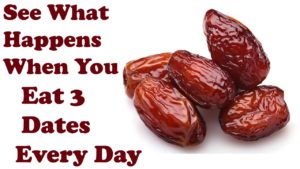
There are some foods that are recommended to eat every day. We mentioned one of them yesterday, namely ginger 1 . Another one that’s arguably got a high enough pedigree to be included in our daily diet is the humble date. But what’s so good about the phoenix dactylifera (Latin name of dates), particularly when they are known to contain as much as 80% sugar? Surely they can’t be so healthy! Well, read on…
Blog Contents
What does research say about dates?
We’ll look briefly at just two studies ,which should be quite sufficient to give you an idea of just how desirable these sweet treats really are.
Study #1
A 2009 study 2 pointed out the following facts about date fruits and seeds – the latter of which you would not eat unless it had been prepared and ground up; the former is the chewy bit that we eat:
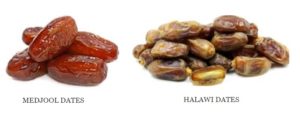
- total phenolics 3 concentration in the halawi versus medjool dates was greater by 20-31%
- the major proportion of the soluble phenolics in both date varieties consisted of phenolic acids, mainly ferulic acid 4 , coumaric acid 5 derivatives, and also chlorogenic acid6 and caffeic acid 7 derivatives
- unlike the medjool dates, halawi dates contained a significant proportion of catechins 8 as well
- both varieties contained a quercetin 9 derivative
- both date varieties possess antioxidative properties in vitro, with the ferric ion reducing antioxidant power of halawi being 24% higher than medjool dates
Chemical composition of medjool and halawi dates (from study #1)
The following table shows just some of the chemical contents in these two date varieties:
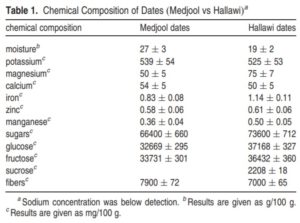
What were the effects on human health?
The subjects consumed around 100 grams of either medjool or halawi dates for a period of 4 weeks. An average date would weigh around 20-30 grams depending on type and size, so that’s between around 4 or 5 dates a day. The following effects were recorded:
- date consumption did not significantly affect the subjects’ body mass index (BMI)
- serum total cholesterol and cholesterol levels in the VLDL, LDL, or HDL fractions were also not affected
- importantly, fasting serum glucose and triacylglycerol levels were not increased after consumption of either date variety – in fact, serum triacylglycerol levels significantly decreased after consumption of both types of date
- basal serum oxidative status was significantly decreased as compared to the levels observed before consumption
- susceptibility of serum to AAPH-induced lipid peroxidation decreased by 12%, but only after halawi date consumption
- serum activity of the HDL-associated antioxidant enzyme paraoxonase 1 (PON1) 10 significantly increased after halawi date consumption
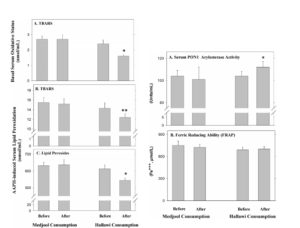
Study conclusion
The researchers concluded that: “…date consumption (and mainly the Hallawi variety) by healthy subjects, despite their high sugar content, demonstrates beneficial effects on serum triacylglycerol and oxidative stress and does not worsen serum glucose and lipid/lipoprotein patterns, and thus can be considered an antiatherogenic nutrient.”
Study #2
This 2003 study 11 speaks very highly of the power of dates, as could be inferred from the title of the study: “The fruit of the date palm: its possible use as the best food for the future?” So what claims do the authors make?
- dates contain a high percentage of carbohydrate (total sugars, 44-88%), fat (0.2-0.5%), 15 salts and minerals, protein (2.3-5.6%), vitamins and a high percentage of dietary fibre (6.4-11.5%)
- the flesh (the part we eat, referred to above as the fruit of the date) contains 0.2-0.5% oil, whereas the seed contains 7.7-9.7% oil
- the fatty acids 12 occur in both flesh and seed as a range of saturated and unsaturated acids,
- the seeds containing 14 types of fatty acids
- the flesh contains 8 types of fatty acids in very low concentration
- the unsaturated fatty acids include palmitoleic, oleic, linoleic and linolenic acids
- the oleic acid content of the seeds varies from 41.1 to 58.8%, which suggests that the seeds of date could be used as a source of oleic acid
- there are at least 15 minerals in dates
- potassium can be found at a concentration as high as 0.9% in the flesh while it is as high as 0.5% in some seeds
- other minerals and salts that are found in various proportions include:
- boron (building strong bones, muscles and improving thinking skills and muscle coordination)
- calcium (building/maintaining bones, vital for blood clotting, muscle contraction and heartbeat)
- cobalt (processes vitamin B12, treats anaemia, repairs/protects nerves, helps form red blood cells)
- copper (helps collagen-formation, iron-absorption and plays a role in energy production
- fluorine (protecting teeth against decay)
- iron (bodily growth/development, protein metabolism, forming haemoglobin/red blood cells)
- magnesium (bone health, calcium absorption, heart health, anxiety-prevention)
- manganese (formation of connective tissue/bones/blood-clotting factors/ sex hormones, important for fat/carbohydrate metabolism, calcium absorption, blood sugar regulation
- phosphorous (energy production (ATP), bone health, structural role in nucleic acids/cell membranes)
- selenium (cancer-prevention and important for immune function)
- sodium (helps control fluid balance, helps send nerve impulses, affects muscle function
- zinc (immune system, making proteins/DNA, helps wounds heal, important for taste and smell)
- the protein in dates contains 23 types of amino acids, some of which are not present in the most popular fruits such as oranges, apples and bananas
- dates contain at least six vitamins including a small amount of the following:
- vitamin C
- vitamin B1 (thiamine)
- B2 (riboflavin)
- vitamin B3 (nicotinic acid -niacin)
- vitamin A
- the dietary fibre of 14 varieties of dates has been shown to be as high as 6.4-11.5% depending on variety and degree of ripeness
- dates contain 0.5-3.9% pectin, which may have important health benefits and is used for high cholesterol, high triglycerides, and to prevent colon cancer and prostate cancer. It is also used for diabetes and gastroesophageal reflux disease (GERD)
Study conclusion
Just based on the above impressively wide range of nutrients, the researchers conclude that: “In many ways, dates may be considered as an almost ideal food, providing a wide range of essential nutrients and potential health benefits.”
Additional information
Dr Greger provides additional information in an article 13 and video 14 on the subject.
Joe’s comment
If you want to include dates in your daily intake, I would suggest that you could think about doing what I do, and add 2-3 chopped dates to a daily breakfast15 muesli. Another lovely snack is to have 3 dates with the 6 walnut halves that I also recommend each day (the latter, in order to get their omega-3 benefits). I’ve also mentioned previously how useful dates are as an alternative and completely healthy sweetener 16 17 .
The two studies mentioned above give the bones of why dates are so packed with goodness. There are many other reports of their benefits, and I’m sure that as research progresses, even more benefits will appear – and, the sweetest thing of all – there are no known negative side-effects…
References
- Ginger Reduces Exercise-Induced Muscle Pain [↩]
- J Agric Food Chem. 2009 Sep 9;57(17):8010-7. doi: 10.1021/jf901559a. Effects of date ( Phoenix dactylifera L., Medjool or Hallawi Variety) consumption by healthy subjects on serum glucose and lipid levels and on serum oxidative status: a pilot study. Rock W, Rosenblat M, Borochov-Neori H, Volkova N, Judeinstein S, Elias M, Aviram M. [↩]
- Wikipedia: Pheolics or phenols [↩]
- Wikipedia: Ferulic acid [↩]
- Benefits of coumaric acid [↩]
- Benefits of chlorogenic acid [↩]
- Benefits of caffeic acid [↩]
- Benefits of catechins [↩]
- Benefits of quercetin [↩]
- Nutrients. 2015 Jun; 7(6): 4068–4092. Published online 2015 May 27. PON1 and Mediterranean Diet. José M. Lou-Bonafonte, Clara Gabás-Rivera, María A. Navarro, and Jesús Osada. [↩]
- Int J Food Sci Nutr. 2003 Jul;54(4):247-59. The fruit of the date palm: its possible use as the best food for the future? Al-Shahib W1, Marshall RJ. [↩]
- Essential Fatty Acids: The Physicians Committee [↩]
- nutritionfacts: dates [↩]
- Are Dates Good For You? Michael Greger M.D. FACLM December 14th, 2010 Volume 4 [↩]
- OATS WITH FRUIT, SEEDS AND NUTS [↩]
- Sugar, Honey & Other Sweeteners [↩]
- Butter, Shortening, Fats and Oils [↩]
